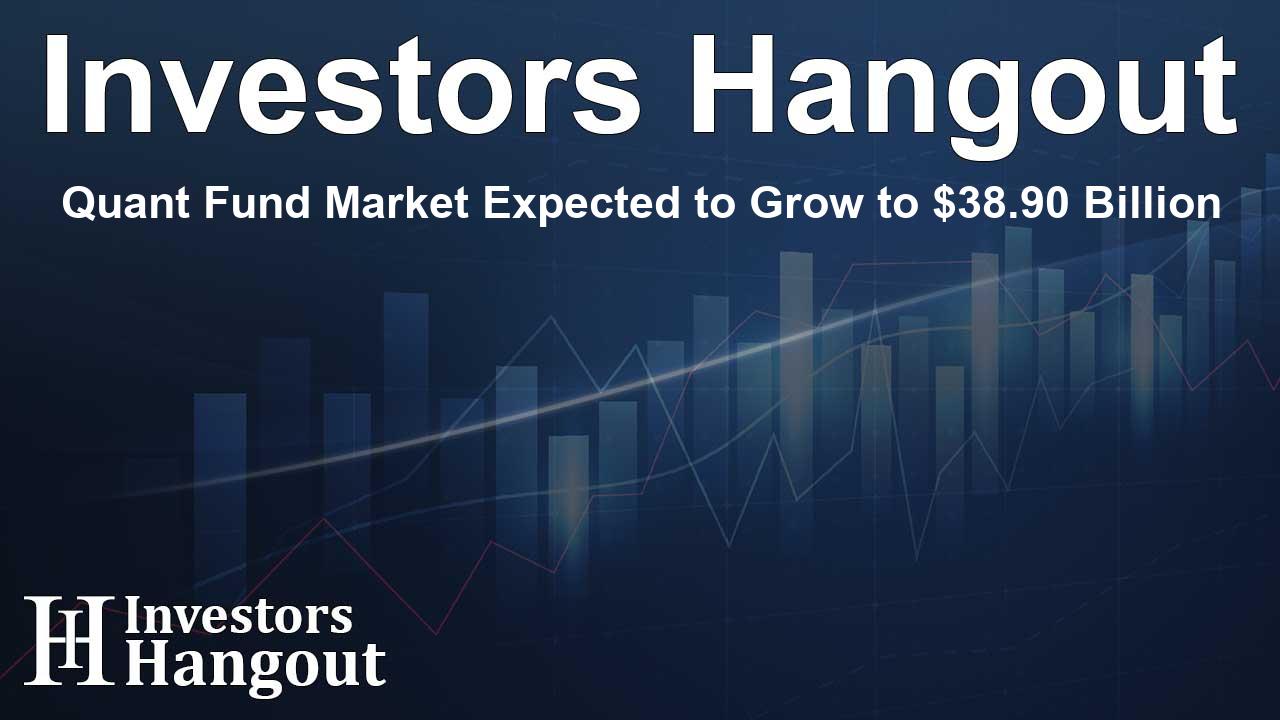Quant Fund Market Expected to Grow to $38.90 Billion

Exploring the Future of the Quant Fund Market
The quant fund market continues to grow, with estimates predicting it will reach USD 38.90 billion by the end of the projected period. This marks a significant increase from its 2023 valuation of USD 15 billion. By utilizing analytical models and algorithms, quant funds leverage data-driven strategies that aim to identify trading opportunities in financial markets.
Understanding Quant Funds
Quant funds employ various algorithms and mathematical models that utilize historical data to predict market trends. Their approach combines sophisticated analysis with speculative assessments that serve to guide investment decisions. As a result, these funds offer a higher level of adaptability, allowing them to manage diverse asset classes across multiple markets. This reduces potential investment risks and enhances the probabilities of higher returns.
The Role of Data Analysis
At the core of quant funds is the capacity to analyze vast amounts of data. By recognizing patterns and trends within both historical and real-time data, quant fund managers can make informed decisions that may lead to superior investment performance. This strategic advantage aids human analysts, enabling them to discover overlooked investment opportunities in a timely manner.
Market Growth Insights
North America is positioned to lead the charge in the growth of the quant fund market. Factors contributing to this dominance include a well-established financial market and access to advanced analytical tools. A heightened awareness among investors has further boosted the market, particularly in attracting high-net-worth individuals (HNIs) and institutional investors who recognize the value of quant funds.
Segment Insights
Breaking down the quant fund market by segments indicates that trend-following funds have claimed the largest share, accounting for approximately 36% of the market in 2023. Meanwhile, the indirect sales segment emerged as the leader in revenue generation within the application segment, reflecting a growing preference for these strategies among investors.
Technological Advancements Driven by Market Demand
The ongoing evolution of technology presents new opportunities for the quant fund market. As businesses strive to process massive amounts of data efficiently, advancements in machine learning and artificial intelligence are integral in developing sophisticated prediction models. These tools enhance decision-making capabilities, potentially boosting profits while mitigating risks. Furthermore, the integration of big data analytics has intensified the competitive nature of the quant fund landscape.
Challenges and Restraints
Yet, within this advancing sector, challenges persist. A highly competitive environment has emerged, with numerous players applying similar strategies and algorithms leading to potential market saturation. This scenario not only compresses profit margins but also raises concerns regarding liquidity and execution timeliness.
Key Players in the Quant Fund Arena
Several notable firms are pivotal to the quant fund market, including Acadian Asset Management, AQR Capital Management, and Citadel LLC, among others. Their innovative contributions foster ongoing advancements in investment strategies and model developments, further fueling market expansion.
Concluding Insights
As we look toward the future of the quant fund market, it is clear that both prospective opportunities and emerging challenges will shape its trajectory. However, with the expected growth to USD 38.90 billion by 2033, investors are presented with substantial potential to capitalize on this evolving landscape.
Frequently Asked Questions
What is a quant fund?
A quant fund is an investment fund that uses mathematical models and algorithms to make investment decisions based on quantitative analysis.
Why is the quant fund market growing?
The market is growing due to advancements in technology, a shift toward data-driven decision-making, and increasing awareness among investors.
What factors contribute to the dominance of North America in the quant fund market?
The established financial market, access to advanced tools, and a high concentration of institutional investors contribute to North America's market dominance.
What segments are included in the quant fund market analysis?
The market is segmented by type, application, and region, highlighting trends in trend-following funds and indirect sales.
What challenges does the quant fund market face?
The market faces challenges from saturation, competition, and the need for technological reliability, which can affect profitability and market dynamics.
About Investors Hangout
Investors Hangout is a leading online stock forum for financial discussion and learning, offering a wide range of free tools and resources. It draws in traders of all levels, who exchange market knowledge, investigate trading tactics, and keep an eye on industry developments in real time. Featuring financial articles, stock message boards, quotes, charts, company profiles, and live news updates. Through cooperative learning and a wealth of informational resources, it helps users from novices creating their first portfolios to experts honing their techniques. Join Investors Hangout today: https://investorshangout.com/
Disclaimer: The content of this article is solely for general informational purposes only; it does not represent legal, financial, or investment advice. Investors Hangout does not offer financial advice; the author is not a licensed financial advisor. Consult a qualified advisor before making any financial or investment decisions based on this article. The author's interpretation of publicly available data shapes the opinions presented here; as a result, they should not be taken as advice to purchase, sell, or hold any securities mentioned or any other investments. The author does not guarantee the accuracy, completeness, or timeliness of any material, providing it "as is." Information and market conditions may change; past performance is not indicative of future outcomes. If any of the material offered here is inaccurate, please contact us for corrections.